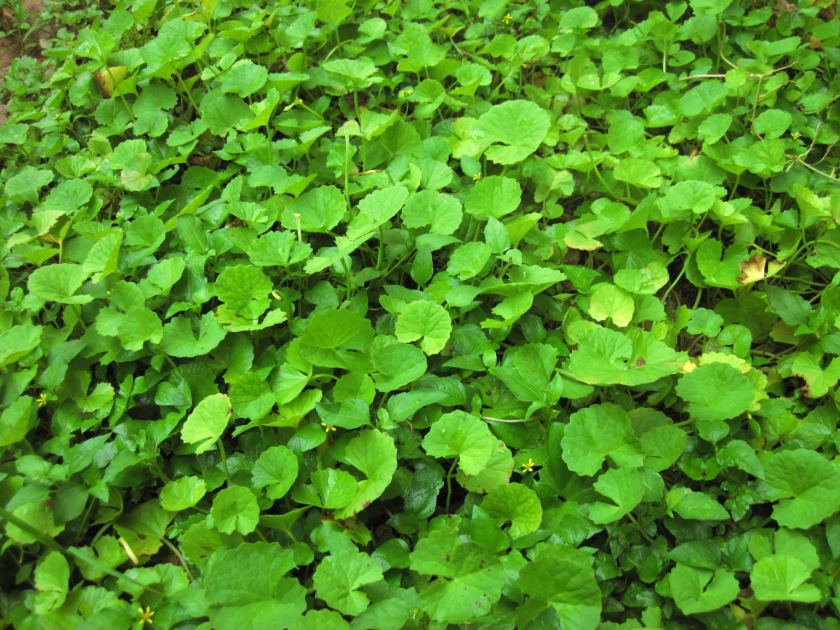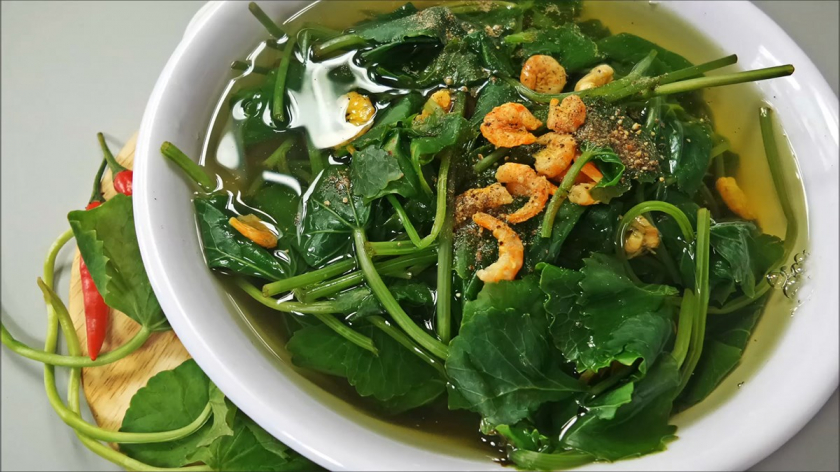We, the children of the late 7X generation, when we still wore ripped pants (late primary school, early secondary school), usually went to school in one session, herded buffaloes and cut grass in the other, helped our parents with farm work, or wandered around the low-lying countryside. Catching cicadas, climbing trees, wading in fields, catching fish, running, jumping, screaming, diving into hills, bathing in ponds... there was nothing we couldn't do, happy, healthy, full of joy, not miserable like the children with nearsighted eyes, pale skin, looking bewildered and miserable with backpacks full of books that bent their backs like now.
I guess pennywort is found everywhere in the Northern Delta, but perhaps the land of Ai, Thanh Hoa, is a "spiritual land" with abundant products and many "talented people", and every year often "welcomes" a few storms, so this "vegetable" has become so "well-known". As mentioned above, the homeless children wearing torn pants and sandals (barefoot) go to school in the morning, come home at noon, cook a few bowls of rice with braised fish sauce, and in the afternoon, each child carries a hoe and a basket (a kind of basket with a shallow bottom, woven from large, hard bamboo strips with large holes) and call each other to go "pick pennywort".

A green field of pennywort.
“Cây” is a verb, a more common name, but back then we called it “cây”, which means (using hands) to pry something out (in this case, pennywort).
So when we go to find vegetables, why is it called “picking” instead of “picking”? “Picking” (or plucking, striping…) is the act of using your hands to break flowers, fruits, leaves, and branches off the plant to take home. But pennywort is actually a herbaceous plant with small leaves and creeping stems close to the ground, growing in crooked, wriggling clumps, not growing high like grass. To “pick pennywort” properly and effectively, we go along the edge of the field or the dike. This Qingming Festival is the time when pennywort grows the greenest. Find a patch of land with a lot of pennywort, stop to claim a spot, put down the basket, and use a hoe to “pick” a square piece of soil as big as a brick (about 20-30cm long and wide). The soil on the dike or field edge is usually moist and soft. After digging the four sides, use your hands to pick it up and then sit down… prying/picking out each pennywort plant in it, throwing it into the basket.
Just like that, leading the soil, sitting and picking, then leading the soil, sitting and picking… all afternoon, the good ones can sometimes find a whole basket of pennywort with very tall shoots. In places where pennywort grows thickly, young, in soft, moist mud, to save effort and time, there is no need to lead, just sit and pick the leaves, put them in the basket.
Usually, the guards with a horn made of sea shells or buffalo horns forbade us from picking pennywort on the dike slopes. Because we had to dig a lot, dig out many pieces of soil, affecting the dike, dangerous in the flood season. But if under the main roads leading to the fields or the banks of the fields, it was small, far away, had to wade, sometimes to meet the target that our mother gave us today, we had to bring home a basket of pennywort, we still "timed" the guards to go somewhere far away to go into the dike... to steal.
Picking pennywort is a rather meticulous game but sometimes brings unexpected joys. After finishing hoeing and digging up the soil, suddenly a mouse hole, or a crab hole, or a frog hole appears, it must be said to be fun. Calling each other to dig crabs, catch frogs or run around looking for straw and firewood to smoke the field mice, the children's laughter and chatter stir up the whole field in the damp, drizzly afternoon of late spring.
There are two types of gotu kola in my hometown. The edible type is the regular gotu kola, with larger leaves, a round shape with a concave part leading down to the stem, and a purple stem when old. The gotu kola bush that is old enough also has roots. When we come across a gotu kola bush with a large base, and shake it with our hands to see if there are roots, we often try to pry out the whole root. I remember the time I went to Tibet, when I stood watching the Tibetan tour guide count each cordyceps to put in boxes to sell to customers, I exclaimed in surprise and delight, because it looked very similar to... the small, rough, gray-black old gotu kola root from my hometown.

Gotu kola is now also often ground into powder.
The pennywort root is crunchy when eaten, like biting into a chicken leg. A basket with many roots shows that the pennywort is at the end of its season, and the fresh, sweet, green variety is almost gone.
The second type is called fragrant pennywort. This type is usually inedible because it has a pungent smell, thin leaves, small and crooked stems, clear in color and smaller than regular pennywort leaves, round edges with fine hairs all over the leaves and stems, looks prettier and grows more than the edible type.
It is true that useless things are often abundant. After plucking pennywort from the ground, the pennywort and weeds mixed in must be picked and thrown away. The best quality part is taken to a pond or lake, cleaned, and brought back. The final product is soaked in well water, sprinkled with salt for disinfection, scooped out to pick out the weeds one last time before being cooked.
Gotu kola soup with minced meat is a modern-day specialty, its sweet, cool, fragrant, and delicious taste is beyond description. But back then, there was no minced meat to make soup. A whole basket of gotu kola was grabbed by my mother in one hand, and the other hand held a knife and sliced it, after a few times of grabbing it, it was done. “Thanh minh in the month of March…”, but it was also the occasion of “March 8th”, meaning the time of the crop break, the rice in the rice jar was almost empty while the rice in the field had just passed the milk stage and was gradually becoming firm. I remember one meal, there were seven people in the family, my parents and five little children, but only two bowls of rice, the pot of rice was boiling, my mother opened it and poured in a whole basket of gotu kola. When the rice was cooked, she brought it up, and served the bowls, each bowl was a dark green with the painful color of gotu kola…

Gotu kola is often used to cook minced meat and dried shrimp.
Eating rice mixed with pennywort makes you feel hungry quickly, it doesn't fill your stomach like rice mixed with sweet potatoes or cassava. And what about side dishes? Back then, where did we get the habit of eating food first until we're almost full like now, then making a little rice at the end of the meal to add starch? It was just a pot of soup with no driver and a bowl of fish sauce. Adding a little fish sauce still made sense, but pennywort mixed with rice and soup was no different from mixing vegetables with vegetables like "Chau Ve Hop Pho".
Telling this to remind us of the memories, that quiet, simple, rustic wild vegetable has become a part of our childhood memories, has contributed to raising us to become adults. And reading this, maybe many people have some more suggestions for interesting dishes to come in the family meal: pennywort soup with minced meat, stir-fried pennywort, pennywort smoothie or even rice mixed with pennywort.
As a "true pennywort person", it was not until more than 20 years ago, when I was wandering around Saigon, earning enough to pay for rent, gas, and monthly food, that I learned about pennywort smoothies. Pennywort juice is green and sweet, but I don't know why, no matter where I drink it, whether it's from Uncle Ba's cold ginseng cart on the side of Bong bridge or in an air-conditioned cafe, I still find it a bit gritty, and the smell of the water and the smoothie is a bit strong, not as intact as pennywort picked from the rice fields and dikes of my hometown.
Truly homeland – no matter where we go, we will never forget each other…



























